

The starting continent was mine at last, and the age of sail was now upon me. Before I go any further though, I will provide a map of the southern regions of my continent, snapped in 1200AD just before the English were ejected from their last city:
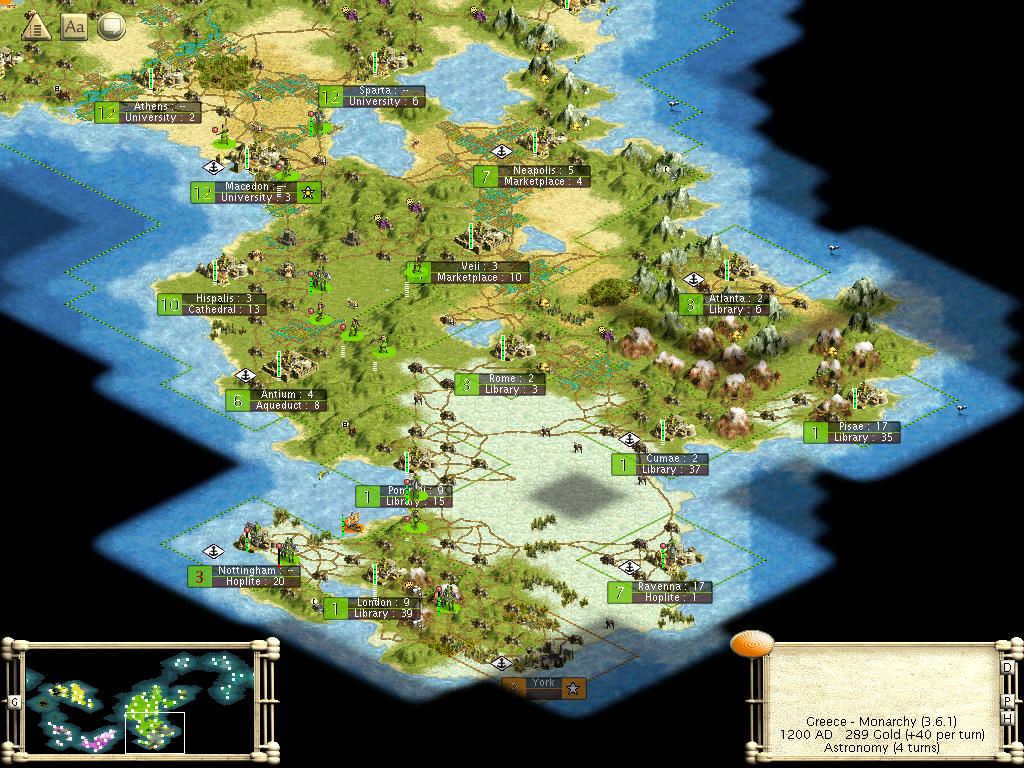
Now perhaps you can actually see where all the cities I described before are located! The Romans and English had very poor land for the most part, almost as bad as the jungle and hill-infested starting positions of the Zulus and Indians. America and me as Greece were the only civs that really had positions where expansion was possible in a bunch of different directions. Note also the locations of China, France, Persia, and Egypt on the map. With China/France only a stone's throw away to the west, I planned to go after them first. Then I would go after Persia since they had the Great Lighthouse and were the only civ that could actually reach me, much to my annoyance. Egypt would be last, followed by the other civs that were hiding out there in the fog. You can see I'm researching Astronomy at this point, which would give me caravels and allow me to reach the other islands without sinking. The next thing I researched after that was Navigation, which made all my ships unsinkable and allowed for the start of major fog-busting to find the other civs. With the English gems, I was down to just 10% luxuries and could get up to 60% science at a profit. Nice!
Persia proved themselves to be even more of a pain in 1250AD by landing a spear/immortal combo next to Karachi where I had minimal forces at best. I survived that attack and rushed two catapaults there that added much needed security to the small offshore island I had seized from India. The next couple turns were spent organizing a fleet of caravels to transport a group of knights over to China and attack. Unlike the AI civs, I wasn't going to trickle units over there so they could easily be picked off; I planned a massive invasion that would strike all at once and run them over before they had a chance to react. In 1275AD I launched my first armada with 15 knights aboard:
This image has been lost.
Each caravel has 3 knights on board, which unfortunately is the maximum that they can carry. I'll be interested to see if anyone invaded another continent using Great Lighthouse-enhanced galleys; that would be difficult logistically but certainly possible. Well, in any case the armada landed in China in 1285AD and their cities began falling like dominoes. China and France had apparently been at war for most of the game, and as a result they were way behind me in tech and had few forces. My knights laughed at Chinese spears and archers while almost casually ripping through their core cities. Beijing fell in 1290AD, Shangahi in 1295AD, Canton in 1305AD. Those were the only three Chinese core cities, though they had many others out to the west on a series of islands. France had appareantly taken Nanking and Tsingtao from them at some point earlier in the game; Mao was in bad shape even before I entered the picture. And more good news: in capturing Canton in 1305AD, I had the fortune to see leader #6 pop out!
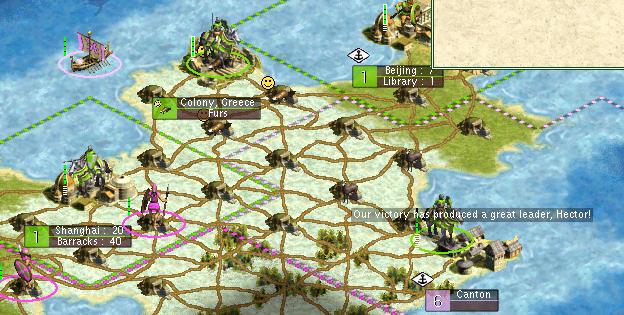
Hector was used on a very important wonder for this game: Magellan's. Rather than waste a few turns sending Hector back to the mainland, I simply rushed the wonder in Beijing. It saved me 112g on a library rush and if Beijing flipped (highly unlikely) I'd just take the city back, after all. I pushed onward and the tide of knights didn't stop at the border with France; what border? We're at war with everyone! More reinforcements were landing almost every turn from my mainland and I was losing almost no knights in my driving attack. Due to some rough terrain (hills and tundra forests) I didn't capture my first French city until 1315AD, which was interestingly named Tsingtao. Nanking followed from France in 1325AD, and in 1335AD I took Paris and used its cultural radius to leapfrog to Lyons as well. At that point I decided to take a picture of the China/France island in midconquest so the reader can see what I was facing.
This image has been lost.
Notice the French galleys running around to no real purpose whatsoever. They would occasionally drop off a unit behind my lines, which would be killed by a knight rather easily. They wouldn't attack my caravels for the most part, although every now and then one would suicide. They were just irritating. Perhaps the most significant thing from this screenshot is that for the first time in ages I have been able to run 0% luxuries due to my capture of Chinese furs. Very unusually for one of my games, I have discovered Astronomy and Navigation before Banking - normally getting banks and Wall Street is far more important than building better ships. Not in this case though. I should also mention that in 1335AD I completed building Copernicus manually (not leader-rushed) in Washington. By this point in time, I had decided not to rely on leaders since I wasn't getting any and to simply build the Middle Age wonders myself instead. It would also score me more scenario points too, not that I was really playing for that.
Keep in mind with the above picture that I had landed on the island in 1385AD, so that was the progress of only 10 turns across some rather rough terrain. Not bad if I do say so myself. The march to the west of the island continued, with Marseilles falling in 1340AD, Rheims in 1345AD, and Orleans in 1350AD. With the fall of Orleans, the French were completely evicted from their starting island and Joanie was forced to carry on the struggle from the innumberable islands to the west. Xinjian was taken from China just a bit later in 1360AD, and Mao too was cast adrift on the seas never to return to his home island. 1360AD was also an important date because two French galleys attacked one of my caravels, sending it to elite status when it defeated both. That's also quite late, so I'm sure someone else will get the points for that objective. Now the goal would shift to invading each one of the islands that formed a large archipelago to the west. The island chain looked a little bit like this:
This image has been lost.
Even Persia had somehow gotten a settler up to that top island, so invading each of them would be a long task. This picture is of course from 1270AD, when I had captured the Chinese city of Hangchow. While on the subject of Persia though, I should mention that I had started building up an army and a fleet to invade their continent around 1350AD when it became apparent that the forces I had in China/France were going to be sufficient to do the job there. So I cut off reinforcements to that island and began sending my knights up to former India to prepare for another large-scale invasion. This force would be cut off from my homeland by a good 7-turn voyage, so it had to be strong enough to carve out a beachhead for itself and survive until reinforcements could arrive. I targeted Persia's southern of its two main islands as a good point to attack, since I could use it as a staging area for my attack on their home island. The Persian invasion fleet, also consisting of 15 knights in 5 caravels, set sail in 1380AD on its long voyage.
I also captured Tientsin in 1380AD from China. I then split up the dozen knights I had remaining of my earlier army into two groups and sent six of them down to the small island in the south while the other six pushed on to Chengdu. In 1390AD this plan came to fruition as Tatung, Macao, and Chengdu were all captured on the same turn. China was reduced to its last two cities.
1400AD was an important turn for the game, as a number of things occured that would have highlighted any other turn individually. For starters, Smith's was completed manually in Delphi thanks to a longtime Leo's prebuild. This gave me back about 50gpt and allowed me to focus more on research; namely, on getting to cavarly sooner and making the game end a lot faster. Secondly, my Persian invasion fleet finally landed on their southern island and prepared for combat on the next turn when they could move again. Finally, I made contact with one of the remaining two civs: the Aztecs. If you'll look at the above minimaps, you'll see that I had been pushing back the fog with a number of exploring caravels. One of them finally spotted the Aztecs (who were far, far away from anyone else) now in 1400AD. I traded for their world map, noted that they had a fair amount of land but were hopelessly behind me in technology, and declared WAR. Here's my caravel making contact:
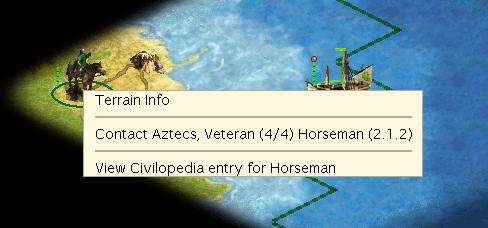
It had been a big turn all around for me. In 1405AD I captured Tours and reduced France to their last city. At the same time on the other side of the world, I captured both Samaria and Tarsus from Persia, leaving them with only 2 cities left on their southern island. On the very next turn, I was able to reach Chartres as well, prompting this message:
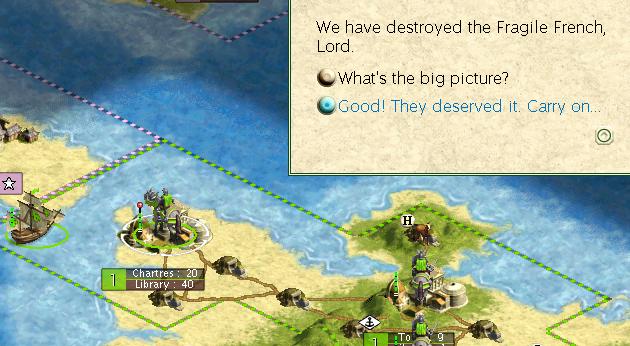
Ahhh, there is no better message in an Always War game than that! 1415AD saw Gordium captured from Persia on their southern island, and Bactra followed in 1420AD giving me complete control over that landmass as well. Over on the diminishing China/France front, Anyang was taken in 1420AD as well to leave Mao with only a single city. I was down to just a half-dozen knights left from my original force of over 30 on the main China/France isle (most were on garrison duty in captured towns, not dead) but they would be enough to do the job. A quick ferry trip with my supporting caravels, and 1430AD achieved this result:
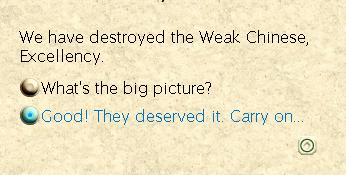
And to make things even better, a leader popped in the taking of Shangtung as well! I would have to find a good use for Ajax since all wonders out there were either built already or under manual construction. Meanwhile, also in 1430AD my wandering caravels met up with the Japanese, the final civ in the game. They had an incredibly poor tundra island north of Egypt and were atrociously behind in technology. I got their world map as well and declared war. With China and France dead, Persia in full retreat from my forces, and my final target civs identified, I was in good shape to finish this game off in grand style in a relatively short period of time. The only question was how quickly I could achieve my goal of a complete conquest victory.
| Greece | America | England | Zululand | Rome | India | China | France | Persia | Egypt | Total AI Civs | 750BC | 2 | 19 | 5 | 4 | 7 | 1 | 0 | 0 | 0 | 0 | 36 |
|---|---|---|---|---|---|---|---|---|---|---|---|
| 250BC | 9 | 38 | 9 | 6 | 11 | 6 | 0 | 0 | 0 | 0 | 70 |
| 250AD | 21 | 55 | 15 | 17 | 26 | 15 | 0 | 0 | 0 | 0 | 128 |
| 650AD | 45 | 59 | 18 | 40 | 67 | 35 | 0 | 0 | 0 | 0 | 219 |
| 900AD | 78 | 59 | 20 | 42* | 107 | 53 | 0 | 0 | 0 | 0 | 281 |
| 1200AD | 120 | 62* | 37 | 42* | 144* | 59* | 0 | 0 | 0 | 0 | 344 |
| 1350AD | 126 | 62* | 41* | 42* | 144* | 59* | 16 | 29 | 8 | 0 | 401 |
Azteca and Japan do not show up on this table because I had not contacted them as yet in 1350AD. Not too much to say here, except for commenting on how low my losses were. Only six units dying; that was due to an uncannily good run of luck with my knights where they would retreat whenever they were down to 1hp. I was also facing much easier foes than the Romans too, but I overall I enjoyed excellent combat results against the French and Chinese. I guess it does all balance out in the end, huh?






